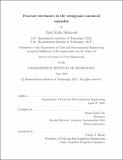Fracture mechanics in the semigrand canonical ensemble
Author(s)
Mulla Mahmoud, Talal
DownloadThesis PDF (26.40Mb)
Advisor
Ulm, Franz-Josef
Terms of use
Metadata
Show full item recordAbstract
We present a novel simulation method to assess the quasi-static fracture resistance of materials. Set within a semigrand canonical Monte Carlo (SGCMC) simulation environment, an auxiliary field –the bond rupture potential– is introduced to generate a sufficiently large number of possible microstates in the semigrand canonical ensemble, and associated energy and bond fluctuations. The SGCMC approach permits identifying the full phase diagram of brittle fracture for harmonic and non-harmonic bond potentials, analogous to the gas-liquid phase diagram, with the equivalent of a liquidus line ending in a critical point. The phase diagram delineates a solid phase, a fractured phase and a gas phase, and provides clear evidence of a first-order phase transition intrinsic to fracture. Moreover, energy and bond fluctuations generated with the SGCMC approach permit determination of the maximum energy dissipation associated with bond rupture, and hence of the fracture resistance of a widespread range of materials that can be described by bond potentials.
We further adapt the method to a hybrid analytical-simulation investigation of the fracture resistance of heterogeneous materials. We show that bond-energy fluctuations sampled by Monte Carlo simulations in the semigrand canonical ensemble provide a means to rationalize the complexity of heterogeneous fracture processes, encompassing probability and percolation theories of fracture within a unified framework of fluctuation-based fracture mechanics. For a number of random and textured model materials, we derive upper and lower bounds of fracture resistance, which are critical to identify toughening mechanisms. Specifically, elastic toughening mechanisms due to elastic energy mismatch are shown to result from both the activation of cooperative interactions in soft-tough bulk phases and interfaces, and the transition from critical to subcritical bond fracture percolation in textured materials. While counter-intuitive on first sight, this soft-tough paradigm can explain a number of experimental observations, including toughening of brittle solids by deformable polymers or organics, such as gas shale, nacre, stress-induced transformational toughening mechanisms in ceramics, and toughening of sparse elastic networks in hydrogels, to name a few.
Date issued
2021-06Department
Massachusetts Institute of Technology. Department of Civil and Environmental EngineeringPublisher
Massachusetts Institute of Technology